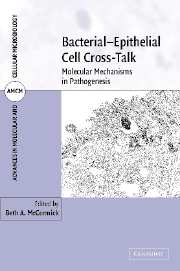Book contents
- Frontmatter
- Contents
- List of contributors
- Part I Introduction to the host and bacterial pathogens
- Part II Bacterial cell biology and pathogenesis
- 3 Bacterial secretion systems
- 4 Microbial molecular patterns and host defense
- 5 Roles of flagella in pathogenic bacteria and bacterial–host interactions
- 6 The role of bacterial adhesion to epithelial cells in pathogenesis
- 7 Bacterial toxins that modify the epithelial cell barrier
- Part III Host cell signaling by bacteria
- Part IV Exploitation of host niches by pathogenic bacteria: mechanisms and consequences
- Index
- Plate section
- References
5 - Roles of flagella in pathogenic bacteria and bacterial–host interactions
from Part II - Bacterial cell biology and pathogenesis
Published online by Cambridge University Press: 12 August 2009
- Frontmatter
- Contents
- List of contributors
- Part I Introduction to the host and bacterial pathogens
- Part II Bacterial cell biology and pathogenesis
- 3 Bacterial secretion systems
- 4 Microbial molecular patterns and host defense
- 5 Roles of flagella in pathogenic bacteria and bacterial–host interactions
- 6 The role of bacterial adhesion to epithelial cells in pathogenesis
- 7 Bacterial toxins that modify the epithelial cell barrier
- Part III Host cell signaling by bacteria
- Part IV Exploitation of host niches by pathogenic bacteria: mechanisms and consequences
- Index
- Plate section
- References
Summary
INTRODUCTION
The quintessential event that initiates an infection is defined by the pathogen encountering a targeted tissue of a host. Mucosal surfaces often serve as an entry point for pathogens, and the pathogens frequently access epithelial cells at these sites with the aid of flagellar-mediated motility. Flagella are common to a diversity of pathogenic bacteria, and their structure is well conserved (Harshey and Toguchi, 1996). The number of flagella produced by a bacterium is tightly regulated, ranging from one up to several dozen per cell depending on the species (Aldridge and Hughes, 2002). Likewise, these organelles may be localized to a single pole or both poles of a cell or may be in a peritrichous arrangement. In some cases, flagellar number and cellular position undergo a regulated change in response to specific environmental conditions. Directional control of motility, either towards a favorable situation or away from a stressful circumstance, is achieved by a chemosensory phosphorelay system, which integrates environmental signals and adjusts the frequency of motor reversals that cause reorientation of bacterial movement (Sournik, 2004; Wadhams and Armitage, 2004). The cumulative affect invoked by the chemosensory system in response to chemical, physical, and physiological cues offers the bacterium a behavioral activity to fine tune its progression through an environment and consequently enhances the ability of many bacteria to infect their hosts.
- Type
- Chapter
- Information
- Bacterial-Epithelial Cell Cross-TalkMolecular Mechanisms in Pathogenesis, pp. 131 - 157Publisher: Cambridge University PressPrint publication year: 2006

